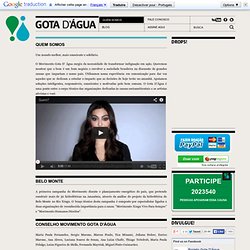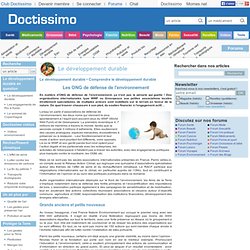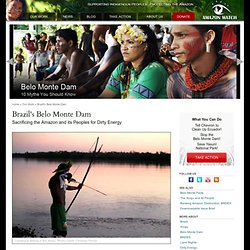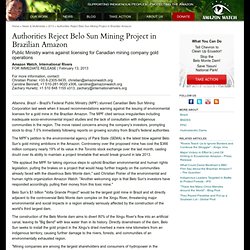

ONG au Brésil - histoire. Gota D'Água. Quem somos Um mundo melhor, mais consciente e solidário.

O Movimento Gota D’ Água surgiu da necessidade de transformar indignação em ação. Queremos mostrar que o bem é um bom negócio e envolver a sociedade brasileira na discussão de grandes causas que impactam o nosso país. Utilizamos nossa experiência em comunicação para dar voz aqueles que se dedicam a estudar o impacto que as decisões de hoje terão no amanhã. Apoiamos soluções inteligentes, responsáveis, conscientes e motivadas pelo bem comum. Belo Monte A primeira campanha do Movimento discute o planejamento energético do país, que pretende construir mais de 50 hidrelétricas na Amazônia, através da análise do projeto da hidrelétrica de Belo Monte no Rio Xingu. Conselho Movimento Gota D'Água. ONG défense de l'environnement - Comprendre le développement durable. En matière d’ONG de défense de l’environnement, ça n’est pas la pénurie qui guette !

Des organisations internationales type WWF ou Greenpeace aux petites associations locales étroitement spécialisées, de multiples acteurs sont mobilisés sur le terrain en faveur de la nature. De quoi trouver chaussure à son pied, du soutien financier à l’engagement actif… Lorsqu’on parle d’associations de défense de l’environnement, les deux noms qui viennent le plus spontanément à l’esprit sont souvent ceux du WWF (World Wild Fund) et de Greenpeace. La première revendique 4, 7 millions de membres à travers le monde, tandis que la seconde compte 3 millions d’adhérents.
Elles soutiennent des causes analogues, espèces menacées, écosystèmes à préserver ou à restaurer... Mais ce ne sont pas les seules associations internationales présentes en France. Grands anciens et petits nouveaux Au niveau hexagonal, c’est France Nature Environnement qui occupe le premier rang avec ses 850 000 adhérents. Bertrand Mauvy. WWF Brasil - WWF Brasil -
AMAZON WATCH » Supporting Indigenous Peoples, Protecting the Amazon. Brazil's Belo Monte Dam. Sacrificing the Amazon and its Peoples for Dirty Energy Traditional fishing in the Xingu.

Photo Credit: Christian Poirier The Brazilian Government is building the world's third largest hydroelectric dam on one of the Amazon's major tributaries, the Xingu River. The Belo Monte Dam complex is designed to divert 80% of the Xingu River's flow, devastating an area of over 1,500 square kilometers of Brazilian rainforest while resulting in the forced displacement of between 20,000 - 40,000 people. The project is causing grave and direct impacts to the land and livelihood of thousands of riverine and urban families, as well as 1,000 indigenous people from several communities, while provoking profound indirect impacts throughout the Xingu basin's communities, rivers, and forests.
No one knows the true cost of the Belo Monte Dam. Project Background The Xingu River Under Threat The Xingu River. The Belo Monte Complex. Project Details Current Status Human Rights and Social Impacts Displacement. Amazon Watch - BeloSun. Amazon Watch, International RiversFOR IMMEDIATE RELEASE | February 13, 2013 For more information, contact:Christian Poirier, +33 6-2305-9435, christian@amazonwatch.org Caroline Bennett, +1 510-281-9020 x306, caroline@amazonwatch.org Zachary Hurwitz, +1 510 848 1155 x313, zachary@internationalrivers.org Altamira, Brazil – Brazil's Federal Public Ministry (MPF) stunned Canadian Belo Sun Mining Corporation last week when it issued recommendations warning against the issuing of environmental licenses for a gold mine in the Brazilian Amazon.

The MPF cited serious irregularities including inadequate socio-environmental impact studies and the lack of consultation with indigenous communities in the region. The move raised concerns among the company's investors, prompting stock to drop 7.5% immediately following reports on growing scrutiny from Brazil's federal authorities. Belo Monte Dam Project. Para, Brazil.

February 12, 2012. Belo Monte is a controversial hydropower plant that is being built in the Xingu River, one of the largest rivers in the Amazon basin. For 20 years indigenous groups, rural communitties and environmentalists have fought against the construction. President Dilma authorized the building after a highly controversial licensing process. Greenpeace flew over the area where the dam will be built (known as Volta Grande) and Altamira, the city that is the base for the building project, to expose the increase of deforestation in the region.